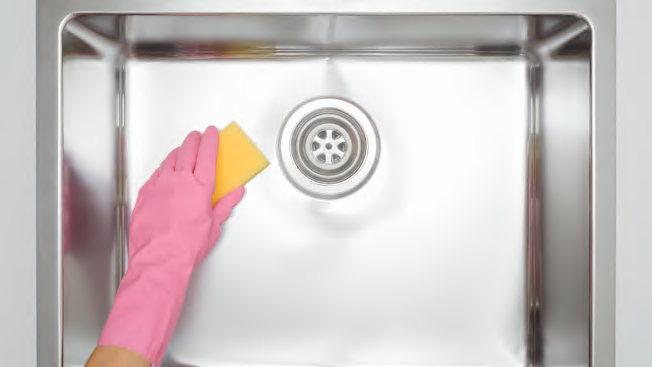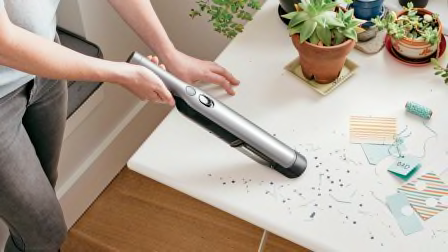Yes, You Need to Clean and Sanitize Your Kitchen Sink and Drain More Often
There are probably more germs in your kitchen sink than in your bathroom

If you ask my mom, she’ll tell you that if you didn’t scrub the kitchen sink after washing the dishes, then you didn’t really finish doing the dishes.
It’s a habit that stuck with me after I was living on my own and that I continue to do every day as the last step in my post-dinner kitchen cleanup. I thought it was a universal daily chore, but after a conversation with a few colleagues who admitted they didn’t know the kitchen sink needed to be cleaned, I began to wonder if maybe my mom had been leading me astray all these years.
- The Basics: Why Clean It? Cleaning the Sink Cleaning the Drain
How often do you need to clean the kitchen sink? And what about the drain? I needed answers to those questions, so I did some digging and spoke with a few experts to find out the truth.
Why You Should Clean Your Kitchen Sink
You’re washing dishes in the sink all day, so why would you need to clean it in the first place? Isn’t it being cleaned while the dishes are washed? Well, turns out the kitchen sink can get pretty germy. NSF International (formerly the National Sanitation Foundation) conducted a study in 2011 with 22 families who were asked to take swabs of 30 items inside their homes.
How to Clean Your Kitchen Sink and How Often
Both the NSF and USDA have outlined how kitchen sinks should be cleaned and sanitized. The NSF says that a disinfecting cleanser should be applied to the sides and bottom of a kitchen sink once or twice a week.
The USDA’s guidelines are a little more specific. It says that the sink should be cleaned and sanitized every time it’s used to wash or prepare food (not just meat). Use warm, soapy water, then wipe it clean with disposable paper towels. Then apply a sanitizer and allow the sink to air-dry. Commercial sanitizing wipes, liquid sanitizers, or a DIY mixture of 1 tablespoon of bleach in a gallon of water are all acceptable types of sanitizers, according to the USDA’s website.
Gerba’s recommendations are similar. He suggests cleaning the sink of any food debris every day and disinfecting it at least once a week. If you don’t clean the sink, the bacteria sitting in the sink could eventually cause odors, he says.
James Rogers, PhD, CR’s director of food safety research and testing, says he cleans up and loads the dishwasher as he and his wife cook to avoid a pileup at the end of dinner prep. Then he does a final cleaning using warm, soapy water and wiping down everything, including the sink, stove, and countertops, especially areas where food has touched or was prepared.
Mause Ramirez, owner of MCS Cleaning Services Inc., a professional home cleaning business in San Francisco since 1995, has a lot to say on the topic. He, too, told us that sinks often stay moist and that if you aren’t cleaning them enough, they can be full of bacteria. And if your sink has a garbage disposal, be mindful that it could spew water and bacteria when turned on.
He recommends cleaning the kitchen sink on a daily basis, and then a weekly cleaning with an emphasis on the bottom and corners. When he cleans a home professionally, he first clears the sink of all dishes and utensils, then washes it with hot water, dish soap, and a sponge, and rinses it very well. Next, he uses a Clorox disinfectant cleaner and lets it sit in the sink for over 30 minutes. “The sink is usually the repository for every dirty dish and disposal of leftovers,” he says. “With that in mind, try to keep your sink empty and clean.”
How to Clean the Drain, Too
If your sink has a garbage disposal, it can be cleaned with items you may already have in your home, like ice cubes, lemons, baking soda, and bleach. Even if your sink doesn’t have a garbage disposal, the drain is one area you’ll want to make sure you don’t forget about. Ross Pascale, owner of Neeet House Cleaning in Melbourne, Australia, says the drain is a major cause of odors and clogs. His DIY recommendation for cleaning it involves two ingredients you probably already have in your kitchen, baking soda and white vinegar.
His advice is to first pour a quarter-cup of baking soda down the drain, immediately followed by a quarter-cup of vinegar. Let the mixture sit for 30 minutes to an hour, then run hot water to rinse it out. “I would tend to do this once a month in my own home,” he says. If you’re dealing with a serious clog, you’ll need a store-bought drain cleaner or the help of a plumber, according to Pascale.
If you decide to go the store-bought route, there are some things to consider when choosing a drain cleaner, though.
The Bottom Line
It’s tempting to assume that the kitchen sink is being cleaned as you’re washing the dishes, but by now you know that isn’t the case. A thorough cleaning at least once a week is necessary to keep it clean. And if you’re a member of the raw meat washing club, cleaning and sanitizing should be happening every single day that you’re handling meat in your kitchen sink. No exceptions.




















